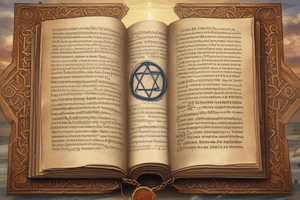Podcast
Questions and Answers
Who developed the Step Reckoner?
Who developed the Step Reckoner?
Gottfried Wilhelm Leibniz
What are the Difference Engine and Analytical Engine known for?
What are the Difference Engine and Analytical Engine known for?
Precursors to modern computers
Who is referred to as the Father of the Computer?
Who is referred to as the Father of the Computer?
Charles Babbage
What did Lady Augusta Ada Byron contribute to computing?
What did Lady Augusta Ada Byron contribute to computing?
What invention is associated with John Napier?
What invention is associated with John Napier?
What was the purpose of Jacquard's Loom?
What was the purpose of Jacquard's Loom?
What did the Slide Rule facilitate?
What did the Slide Rule facilitate?
Who invented the light bulb?
Who invented the light bulb?
What was the IBM 701 also known as?
What was the IBM 701 also known as?
Who developed the Differential Analyzer?
Who developed the Differential Analyzer?
What was the IBM 650 designed for?
What was the IBM 650 designed for?
Flashcards are hidden until you start studying
Study Notes
Early Counting Tools
- Humans have used various tools for counting for centuries
- Sticks, fingers, stones, beads, pebbles, leaves, chicken bones, seeds, shells, and rope were all used
Key Individuals and Inventions
- Gottfried Wilhelm Leibniz (1646-1716) developed the Step Reckoner, a mechanical calculator that could perform basic mathematical operations
- Charles Babbage (1792-1871) is considered the Father of the Computer and designed the Difference Engine and Analytical Engine, precursors to modern computers
- Lady Augusta Ada Byron, known as the first computer programmer, collaborated with Babbage
- John Napier (1550-1670) invented Napier's Bones, made of ivory, for multiplication and long division, also capable of calculating square roots
- William Oughtred created the Slide Rule in 1620, which facilitated faster calculations
- Blaise Pascal invented the Pascaline in 1642 to assist with tax computations
- Joseph Marie Jacquard (1752-1832) created a loom that used punch cards to store data
- Herman Hollerith (1860-1929) developed a card reader to count census data, using it to win a government contract for the 1890 census
- Thomas Edison invented the light bulb amongst other devices influential to computing
- John Ambrose Fleming created vacuum tubes essential for early computers
- Lee DeForest improved on these designs with the Audion tube
First-Generation Computers
- Kelvin’s Tide Predictor was developed by William Thomson in 1876 to predict tides at specific times
- Differential Analyzer was created by Vannevar Bush at MIT in 1930; it combined mechanical and electronic components and used vacuum tubes for storage
- MARK I was built in 1943
- IBM 701 (1952) was also known as the "defense calculator" and was built in separate units for easier shipping and installation; it was the first computer to use magnetic plastic tape for storage
- IBM 650 (1953) was a smaller, more affordable computer designed for a wider range of customers; it could read and write from magnetic tape and punched cards
Studying That Suits You
Use AI to generate personalized quizzes and flashcards to suit your learning preferences.




